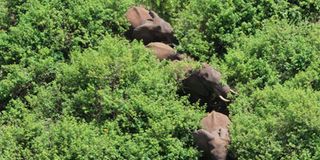Premium
Wild returns: Counties hosting game parks reap billions in tourism revenue

Elephants in the Imenti Forest in Meru. Counties hosting game parks and national reserves are reaping billions of shillings in entrance fees every year from the facilities.
Counties hosting game parks and national reserves are reaping billions of shillings in entrance fees every year from the facilities.
Controller of Budget (CoB) Margaret Nyakang'o in her latest report covering the first nine months of the 2023/2024 financial year said devolved units hosting wildlife reserves earned at least Sh5 billion from tourism sites during the period under review.
The report also highlights untapped resources found in several other counties, which, if exploited, could greatly bolster own source revenues across the country.
Narok, Samburu, Isiolo, and Baringo counties generated substantial amounts from entrance fees to various game parks and reserves.
In Narok, the world-renowned Maasai Mara National Reserve was the county's crowning jewel, generating Sh3.6 billion for the devolved unit.
This amount accounted for 91 per cent of the total revenue generated in the period.
Annual revenue target
In the first nine months of the 2023/2024 financial year, Narok generated a total of Sh3.96 billion from local sources, achieving 76.8 per cent of its annual revenue target.
"The highest revenue stream of Sh3.6 billion was generated from park fees in the Maasai Mara, contributing about 91 per cent of the total own source revenue during the period under review," noted the CoB report.
Other sources contributing to Narok's revenue included fees from health facilities, business permits, cess, and liquor.
In Samburu, which hosts the Samburu National Reserve, revenue collection for the nine months amounted to Sh175,588,339, representing 75 per cent of the county's total own source revenue.
During the period, the county generated a total of Sh232.30 million from its own sources of revenue.
Baringo County generated Sh32.5 million out of a total of Sh272.75 million from local sources in the nine months. Meanwhile, Isiolo County collected Sh117.9 million from game entrance fees and royalties.
Isiolo County, on the other hand, collected Sh117.9 million from the game entrance and royalties.
"The highest revenue stream for Isiolo county in the period under review of Sh117.9 million was from game parks/reserves entrance fees as well as mineral royalties," reads the report.
While other efforts, such as the automation of revenue systems and enhancement of collection measures, continue to contribute to better collections, the substantial income from game parks and reserves underscores the critical role of natural resources in local economies.
Records from the Ministry of Tourism and Wildlife show that about 21 county governments can generate at least Sh35 billion in revenue annually from national parks in their areas.
Currently, revenues in most of the national parks go to the national government while the rest fund daily activities in the facilities.
Corporate social responsibility
Parks also use part of this revenue for corporate social responsibility activities.
In August last year, President William Ruto directed that counties that host national parks share their revenue in a ratio of 50:50 with the national government.
The Tourism Ministry and the Kenya Wildlife Service are developing a matrix and a legal framework, for implementation of the directive.
Some of the counties that are set to benefit from the presidential directive on revenue sharing include; Nakuru, Nairobi, Samburu, Baringo, Narok, Laikipia, Taita Taveta, Nyeri, Turkana and Trans Nzoia.
Others are Homabay, Machakos, Kisumu, Meru, Bungoma, Marsabit, Tana River, Makueni and Nyandarua.
The county governments have over the years been pushing to have a stake in the revenue generated from national parks.
Kajiado County for instance is already salivating at Sh240 million, annually from the expansive Amboseli National Park.
The park rakes in about Sh480 million annually.
Going by President Ruto's plan to have counties and the national government share park revenues, equally, this means Kajiado will retain at least Sh240 million.
Amboseli National Park is located in Kajiado South on the Kenya and Tanzania border.
The park was declared a Unesco site in 1991.
Big five wild animals
Currently, the park is operated fully by the national government under the Kenya Wildlife Services (KWS).
It boasts three of the big five wild animals apart from wildebeests, hippopotamuses, ostriches and zebras among others.
Currently, part of the revenue generated goes to the national government and part of it is used for daily activities in the park, but also the park uses part of this revenue for corporate social services.
Amboseli was gazetted as a national park in 1974 and a section of Maasai leaders have been advocating for reversion of the park back to the county government.
Taita Taveta County has over the years been at loggerheads with the KWS pushing for the Tsavo East National Park to be converted to a game reserve and its management handed over to the county.
The county government has been rooting to have the KWS remit to the county government, at least 30 per cent of the more than Sh60 billion netted every year from the park.
In fact, the county assembly passed a motion in support of the move.
The push has, however, in the past presented a dilemma on how revenue would be divided among the counties bordering the larger Tsavo National Park which includes Tsavo West National Park.
Apart from Taita Taveta, Tsavo also borders Kitui, Makueni, Kilifi, Kwale, Tana River and Kajiado counties.
Tsavo is Kenya’s largest and oldest protected area, occupying at least 60 per cent of Taita Taveta county.
It is estimated that Kenya collects more than Sh60 billion from Tsavo East and West national parks alone annually.
Maasai Mara, Amboseli and Nairobi National Park are considered high-profile by the world tourist community, due to the abundance of wildlife.
The other national parks generate a total of about Sh6 billion.


